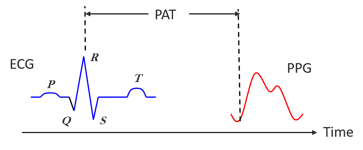Breaking Down Continuous Non-Invasive Blood Pressure (cNIBP)
Sotera’s cNIBP technique is based on a principle called Pulse Arrival Time. To obtain cNIBP, you need both sensors of the ViSi Mobile Monitoring System: the thumb sensor and the chest sensor, plus the cuff module for initial calibration.
The Pulse Arrival Time is the time from the onset of the R-wave of the ECG, to the arrival of the resulting pulse at the base of the thumb. The resulting pulse arrival time correlates with blood pressure. Since every patient has a different cardiovascular profile, an initial “calibration measurement” is taken by means of a cuff-based measurement. For this you use a standard Welch Allyn FlexiPort cuff with the ViSi Mobile cuff module attached to it. This measurement is taken on inflation, during which a “patient specific cardiovascular profile” is created. This profile then allows to measure blood pressure on a beat-to-beat basis.

The ViSi Mobile System can detect the onset of the R wave via the chest sensor and the time it takes for the resulting pulse to be detected by the thumb sensor. This technique is called “pulse arrival time,” which translates pulse wave velocity into mmHg of blood pressure. The default cuff calibration for ViSi Mobile cNIBP is set to calibration against the auscultatory method.
The ViSi Mobile System cNIBP technique has been compared in clinical trials to invasive arterial lines and has shown accuracy in these studies within 5mmHg. As a pulse wave travels down the arterial system, the systolic pressure increases. This is noticeable when comparing systolic blood pressure measured via an invasive arterial line versus auscultation. Sotera Wireless considered how this would impact the adoption of the technology in low acuity care units. As a result, default cuff calibration for ViSi Mobile cNIBP is set to calibrate against the auscultatory method. cNIBP measurements will compare favorably to other non-invasive blood pressure techniques and captures blood pressure on a beat to beat basis.
